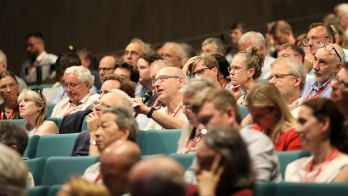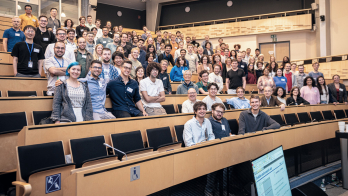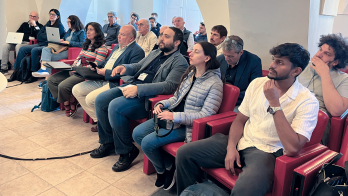
On 10 August, the Muon g-2 collaboration at Fermilab presented its latest measurement of the anomalous magnetic moment of the muon aμ. Combining data from Run 1 to Run 3, the collaboration found aμ = 116 592 055 (24) × 10–11, representing a factor-of-two improvement on the precision of its initial 2021 result. The experimental world average for aμ now stands more than 5σ above the Standard Model (SM) prediction published by the Muon g-2 Theory Initiative in 2020. However, calculations based on a different theoretical approach (lattice QCD) and a recent analysis of e+e– data that feeds into the prediction are in tension with the 2020 calculation, and more work is needed before the discrepancy is understood.
The anomalous magnetic moment of the muon aμ = (g-2)/2 (where g is the muon’s gyromagnetic ratio) is the difference between the observed value of the muon’s magnetic moment and the Dirac prediction (g = 2) due to contributions of virtual particles. This makes measurements of aμ, which is one of the most precisely calculated and measured quantities in physics, an ideal testbed for physics beyond the SM. To measure it, a muon beam is sent into a superconducting storage ring reused from the former g-2 experiment at Brookhaven National Laboratory. Initially aligned, the muon spin axes precess as they interact with the magnetic field. Detectors located along the ring’s inner circumference allow the precession rate and thus aμ to be determined. Many improvements to the setup have been made since the first run, including better running conditions, more stable beams and an improved knowledge of the magnetic field.
The new result is based on data taken from 2019 and 2020, and has four times the statistics compared to the 2021 result. The collaboration also decreased the systematic uncertainty to levels beyond its initial goals. Currently, about 25% of the total data (Run 1–Run 6) has been analysed. The collaboration plans to publish its final results in 2025, targeting a precision of 0.14 ppm compared to the current 0.2 ppm. “We have moved the accuracy bar of this experiment one step further and now we are waiting for the theory to complete the calculations and cross-checks necessary to match the experimental accuracy,” explains collaboration co-spokesperson Graziano Venanzoni of INFN Pisa and the University of Liverpool. “A huge experimental and theoretical effort is going on, which makes us confident that theory prediction will be in time for the final experimental result from FNAL in a few years from now.”
The theoretical picture is foggy. The SM prediction for the anomalous magnetic moment receives contributions from the electromagnetic, electroweak and strong interactions. While the former two can be computed to high precision in perturbation theory, it is only possible to compute the latter analytically in certain kinematic regimes. Contributions from hadronic vacuum polarisation and hadronic light-by-light scattering dominate the overall theoretical uncertainty on aμ at 83% and 17%, respectively.
To date, the experimental results are confronted with two theory predictions: one by the Muon g-2 Theory Initiative based on the data-driven “R-ratio” method, which relies on hadronic cross-section measurements, and one by the Budapest–Marseille–Wuppertal (BMW) collaboration based on simulations of lattice QCD and QED. The latter significantly reduces the discrepancy between the theoretical and measured values. Adding a further puzzle, a recently published value of hadronic cross-section measurements by the CMD-3 collaboration that contrasts with all other experiments narrows the gap between the Muon g-2 Theory Initiative and the BMW predictions (see p19).
“This new result by the Fermilab Muon g-2 experiment is a true milestone in the precision study of the Standard Model,” says lattice gauge theorist Andreas Jüttner of CERN and the University of Southampton. “This is really exciting – we are now faced with getting to the roots of various tensions between experimental and theoretical findings.”
Further reading
Muon g-2 Collab. 2023 arXiv:2308.06230 (accepted by Phys. Rev. Lett.).
BMW Collab. 2021 Nature 593 51.
Muon g-2 Theory Initiative 2020 Phys. Rept. 887 1.







